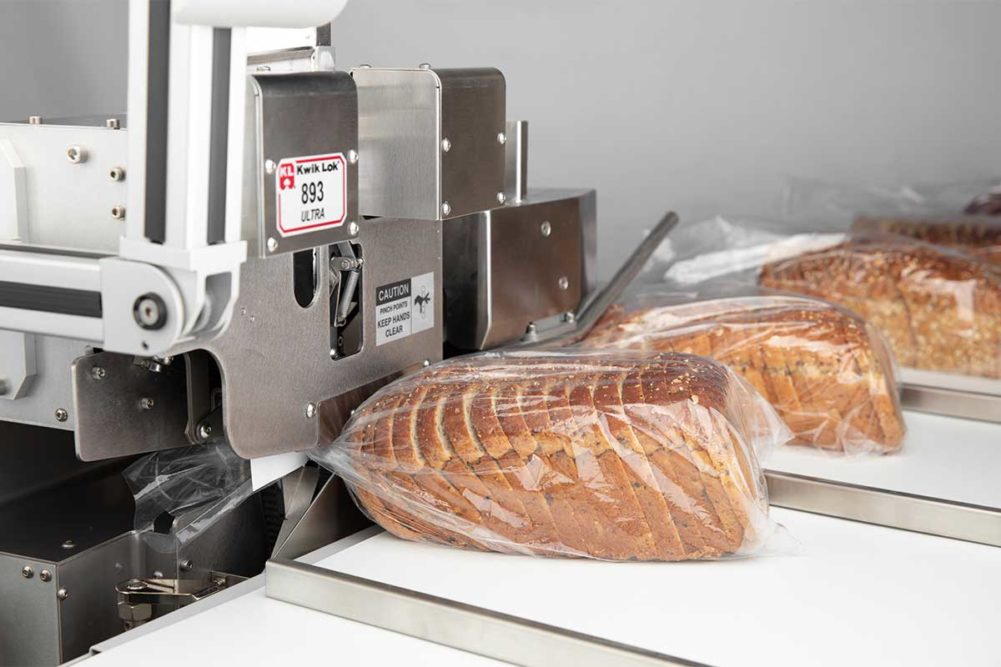With dozens of loaves of sliced bread coming off high-capacity production lines each minute in a bakery, there is no room for error. Every step of the process is crucial, from the right ingredients going into the mixer to the need for reliable packaging equipment.
“You can make the greatest loaf of bread in the world, but if you don’t package it correctly, you have nothing for the consumer,” said Ron Cardey, senior vice president, customer engagement, Kwik Lok.
“Bakers understand the importance. And if it breaks down, you have a real issue because you still have product in the proofer up at that end of the line. And if you don’t get it fixed quickly, you’re going to have a lot of product for a hog farmer somewhere. Everything — the smallest piece of equipment to the largest — has to work together because that line has to keep running to make money for that company.”
Paying attention to the basics and taking care of all the equipment through setup, maintenance, cleaning and employee training will pay dividends for bakers. It sounds easy enough, but when bakeries are stressed and running at full capacity all the time, it’s easy to let a few things slip through the cracks. That can be a costly mistake.
Packaging sliced bread involves multiple pieces of equipment working together: the slicer and bagger to the closer and then through a metal detector before it goes out the door of the bakery. To keep things running smoothly, bakers need reliable equipment that is serviced regularly, which is one of the biggest challenges for bakers.
“If the equipment isn’t properly maintained, it just can’t run optimally,” said Dennis Gunnell, president, Formost Fuji. “Oftentimes what we find is it’s a little thing here and a little thing there, and then three or four little things. All of a sudden they add up to 2%, 3%, 4% less efficiency, and at the end of the day that’s a lot of waste or downtime or operator interaction that shouldn’t have to take place.”
He said problems can come from a variety of sources, such as the compressed air pressure in the plant that is opening bags on the bagger. Routine checks on the equipment such as making sure moving parts are properly lubed and that equipment is checked and cleaned is a good place to start with maintenance. And setting up the machinery correctly is vital as well.
“It’s making sure the bags are put onto the bagger, making sure the blades are sharp, that everything is adjusted properly,” Mr. Gunnell explained. “If someone is sloppy in setting up the slicer, you’re going to get bad slices and you’re going to get doubles, or you’re going to get bad bread out of the slicer, and it just snowballs.”
For bakeries running three shifts, little time is left to perform maintenance tasks.
“Product reject and cripple rates will increase if the basic maintenance tasks are not executed,” said Alain Lemieux, packaging and distribution product group leader, AMF Bakery Systems. “Some bakeries hire the manufacturer’s technical support team to assist in major maintenance routines and train their personnel on site at the same time.”
This speaks to the importance of training operators. High turnover makes this challenging.
“When the machine is taken care of properly and the operators are properly trained, it’s a very smooth operation,” Mr. Gunnell said. “Because it’s a bakery product and no two are alike, every now and then you’re going to have a loaf that doesn’t behave properly. But for the most part, a good line just runs and runs.”
The persistent labor shortage has made finding and retaining workers difficult.
“Workforce retention is a global problem,” said Jimmy Belval, bread packaging team leader at AMF Bakery Systems. “Hiring and keeping qualified operators and maintenance resources directly impacts the bakery’s efficiency as it relates to machine operation, training, general and preventive maintenance.”
Problems upstream in the bread making operation can arise as well.
“Successful bread bagging starts with the production of a quality bakery food that is consistently produced,” said Louis-Bernard Meunier, director of sales for Rexfab. “If the upstream line is producing consistent products, bread bagging should not be a challenge.”
Having backup baggers ready to go when one goes down is another important part of a high-speed line. With dozens of loaves being bagged every minute, bakeries can’t afford to halt production to repair a down bagger.
“The more automated the baking line, the more important it becomes for bakers to consider a backup bread bagger,” Mr. Meunier said. “Using a backup bagger also gives bakers the ability to regularly clean and service the machines so they don’t break down.”
This article is an excerpt from the March 2022 issue of Baking & Snack. To read the entire feature on Sliced Bread Packaging, click here.






